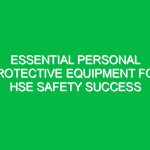Introduction
Safety pictograms play a critical role in the Health, Safety, and Environment (HSE) domain, serving as universal symbols that convey vital information regarding Hazards, safety practices, and emergency Procedures. Their visual nature transcends language barriers, making them essential tools in workplaces where communication might be limited. With the increasing complexity of industrial environments, the need for effective communication of Safety information has never been more pressing. This article delves into the significance of Safety pictograms, exploring their components, benefits, regulations, and Best Practices in promoting HSE compliance.
The Importance of Safety Pictograms
Safety pictograms are designed to communicate specific Hazards or safety information quickly and effectively. They are an integral part of the risk communication strategy in various sectors, including manufacturing, construction, healthcare, and chemical industries.
For instance, consider a construction site bustling with workers from diverse linguistic backgrounds. Here, a pictogram indicating a potential fall hazard can prevent accidents by alerting workers to the danger without needing a verbal explanation. This universal understanding is what makes safety pictograms indispensable in HSE compliance.
Key Aspects of Safety Pictograms
1. Standardization
One of the foremost aspects of safety pictograms is their standardization. Organizations such as the International Organization for Standardization (ISO) and the American National Standards Institute (ANSI) have established guidelines for these symbols. The ISO 7010 standard, for example, provides a set of symbols that are recognized internationally. This standardization ensures that safety pictograms are universally understood, irrespective of language or cultural differences.
2. Clarity and Simplicity
Clarity is paramount in the design of safety pictograms. Effective pictograms should be simple, avoiding intricate details that could lead to confusion. The use of bold colors and clear imagery helps to attract attention and convey messages succinctly. For instance, a red circle with a diagonal line crossing a skull symbol effectively communicates the message “no toxic substance” without requiring any text.
3. Application in Risk Assessment
Safety pictograms are not just tools for Hazard Communication; they are vital in the risk assessment process. By identifying hazards through pictograms, organizations can better evaluate the risks involved in specific tasks. For example, a pictogram of a flame can signify a fire hazard, prompting further assessment and the implementation of appropriate Safety Measures.
Components of Safety Pictograms
Safety pictograms typically consist of three key components: the symbol, the color, and the accompanying text (if applicable).
- Symbol: The symbol is the graphic representation of the hazard or safety measure. It should be easily recognizable and convey a clear message.
- Color: Colors play a crucial role in conveying the severity of the hazard. For instance, red indicates danger or prohibition, while green signals safety or permission.
- Text: While pictograms are primarily visual, supplementary text can enhance understanding. Text should be concise and positioned strategically to avoid clutter.
Benefits of Using Safety Pictograms
Incorporating safety pictograms into an organization’s safety communication strategy offers several Benefits:
1. Enhanced Safety Awareness
Safety pictograms serve as constant reminders of potential hazards, which helps foster a culture of safety among employees. By regularly seeing these symbols, workers become more aware of their surroundings and the risks they may face.
2. Reduced Accidents and Incidents
When safety information is communicated effectively, the likelihood of accidents diminishes. For instance, in a chemical plant, clear pictograms indicating the presence of hazardous materials can significantly reduce exposure risks by ensuring that employees are aware of the dangers before they engage in tasks.
3. Compliance with Regulations
Many jurisdictions require the use of safety pictograms as part of compliance with health and safety regulations. Organizations that adhere to these Standards not only avoid legal repercussions but also demonstrate a commitment to employee safety and well-being.
Best Practices for Implementing Safety Pictograms
To maximize the effectiveness of safety pictograms, organizations should adhere to several Best Practices:
1. Regular Training and Refreshers
Employees should receive training on the meaning and importance of safety pictograms. This training should be part of the onboarding process and include regular refresher courses to ensure that information remains fresh in employees’ minds.
2. Strategic Placement
Pictograms should be placed in prominent locations where they can easily be seen. This could include workstations, entry points, and areas with specific hazards. The placement should consider the flow of work and the potential for distractions.
3. Customization to Specific Environments
While standard pictograms are essential, organizations should also consider customizing pictograms to address specific risks unique to their environments. This customization allows for more relevant communication of hazards that may not be covered by standard symbols.
Potential Hazards and Risks Related to Safety Pictograms
While safety pictograms are designed to protect, there are potential risks associated with their use:
1. Misinterpretation
If pictograms are poorly designed or placed, they can lead to misinterpretation, possibly resulting in unsafe behaviors. For example, a poorly visible pictogram indicating a slip hazard could be ignored, leading to accidents.
2. Overload of Information
Displaying too many pictograms in a single area can overwhelm employees, causing them to overlook critical warnings. It’s essential to strike a balance between providing enough information and avoiding clutter.
3. Cultural Differences
While pictograms aim for universal understanding, cultural differences in symbolism can lead to misunderstandings. Organizations operating in diverse environments must consider these differences when selecting and implementing safety pictograms.
Regulations and Standards Governing Safety Pictograms
Several regulations and standards govern the use of safety pictograms. Understanding these can significantly impact HSE compliance:
1. OSHA Regulations
In the United States, the Occupational Safety and Health Administration (osha) mandates that employers provide a safe working environment. This includes the use of safety pictograms as part of hazard communication standards. Compliance with OSHA regulations helps organizations minimize risks and protect employees.
2. GHS Pictograms
The Globally Harmonized System of Classification and Labelling of Chemicals (GHS) has established pictograms specifically related to chemical hazards. These pictograms are crucial for workplaces handling chemicals, ensuring that employees are aware of the specific dangers associated with various substances.
3. ISO Standards
The International Organization for Standardization (ISO) has developed standards such as ISO 7010, which outlines safety signs and symbols. Adhering to these standards ensures that organizations are aligned with global best practices regarding safety communication.
Conclusion
Safety pictograms are more than mere graphics; they are essential elements in promoting health, safety, and environmental Sustainability. By standardizing symbols, enhancing clarity, and implementing them effectively, organizations can significantly reduce workplace hazards and improve compliance with HSE regulations.
As we navigate increasingly complex work environments, the importance of effective communication cannot be overstated. By investing in the development and implementation of safety pictograms, organizations not only protect their employees but also foster a culture of safety that resonates throughout the entire workplace. Moving forward, it is crucial for companies to continually assess and adapt their safety communication strategies, ensuring that every worker understands the messages conveyed through these vital pictograms.


